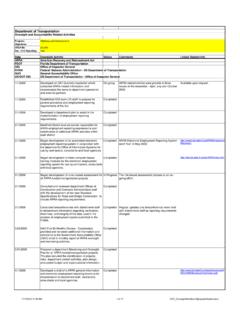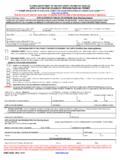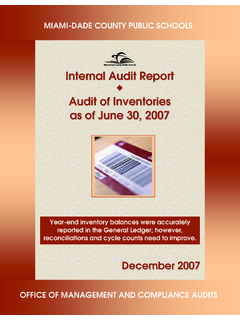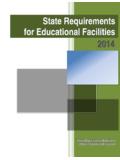Transcription of Florida Department of Transportation
1 Preventative Maintenance StandardsMANUALthe Marketing InstituteThird EditionFlorida Department of Transportation Preventative Maintenance Standards Manual Sponsored by The Florida Department of Transportation Public Transit Office (850) 414-4500 (revised 11/01/11) Written by The Preventative Maintenance Planning, Training and Technical Assistance Program The Marketing Institute College of Business Florida State University (850) 644-2509 For questions regarding maintenance standards, please contact: Laurie Revell, Program Coordinator (850) 644-6956 Julie Eck, Maintenance Review Specialist (850) 644-6954 Steve Stopiak, Maintenance Technical Consultant (863) 602-8515 Fleet Management Managing a fleet of vehicles that are funded by the Florida Department of Transportation requires following a set of minimum requirements established by Chapter 14-90 of the Florida Administrative Code. These standards are created to ensure maximum vehicle life and passenger safety through regularly scheduled preventive maintenance.
2 The Preventive Maintenance Standards Manual is a description of the minimum requirements regarding preventive maintenance inspections and includes basic maintenance oversight practices. Pre-trip/Post-trip Daily Inspections Vehicles should be inspected each day before they enter into service. Chapter 14-90 states that the following components must be checked during this inspection: 1. Service Brakes From the driver s seat pump the brake pedal three or four times, and then hold constant downward pressure on pedal for at least five seconds. The brake pedal should hold firm and not drift down. If equipped with a hydraulic brake reserve system, with the key off, depress the brake pedal and listen for the sound of the reserve system electric motor. If equipped with hydro boost system or vacuum assist system, with the key off, pump the brake at least five times and depress the brake pedal. It should feel firm. Remain holding the pedal and start the engine.
3 The pedal should move slightly to the floor and then rise. Check that the warning buzzer or light is off. 2. Parking Brakes Apply the parking brake and shift vehicle into low gear slightly pulling against the brakes. Vehicle should not move. 3. Tires and Wheels The minimum tire tread depth on steering axle is 4/32 inch in every major groove. No re-caps are allowed on the steering axle. The minimum tread depth on all other tires is 2/32 inch in every major groove. Check all tires for uneven tread wear and cuts or damage to tread and sidewalls. Check for tire inflation by hitting the tires with a mallet or similar device to check for flats. To check for exact tire inflation a tire air gauge must be used. Check rims for bends, damage, or welds. Rims must not have any welding repairs. Check valve stems for damage and for missing valve caps. Check that the wheels and hubs are free of oil or grease. Oil or grease present could indicate a leaking hub or axle seal.
4 Check that all lug nuts are present. Check for signs of rust streaks or shiny threads that could indicate loose lug nuts. Page | 2 4. Steering With the engine running turn the wheel back and forth. Steering play should not exceed 2 inches (on a 20 inch wheel) until the front wheels barely move. 5. Horn Check that the horn works properly. 6. Lighting devices Turn on exterior lights. Turn on 4-way Flashers. Perform a complete walk around of the exterior of the vehicle and check all lights for proper operation and lens for cleanliness. Turn off 4-way flashers and turn on left turn signal and check left signal lights for operation. Turn on right turn signal and check right signal lights for operation. Turn on hi-beam head lights and check for operation. Checking brake lights and back-up lights may require assistance. With someone in the driver s seat instruct them to step on the brake pedal while observing the operation of the brake lights.
5 At this time have the assistance place the vehicle in reverse. Check back-up light operation and back-up alarm if equipped. Turn on all interior lights and check for operation. 7. Windshield wipers Check that the wipers operate smoothly and the arms and blades are secure. Check that the windshield washer works correctly. Windshield should be clean with no obstructions or damage to glass. 8. Rear vision mirrors Mirrors should be secure with no mirror bracket damage. Check for proper adjustment. Check mirror glass for cleanliness or fading. 9. Passenger doors Check doors for damage and that they operate smoothly. Hinges should be secure with seals intact. Check door entry area for debris and any loose or extensively worn flooring. 10. Exhaust system Check tailpipe for placement and secure mounting. Start engine and listen for exhaust leaks and check for exhaust fumes in areas other than the tailpipe end.
6 11. Equipment for transporting wheelchairs Check wheelchair lift doors for operation and damage. Cycle lift from stow position to floor level and check outboard roll stop barrier for proper latching. Page | 3 Cycle lift to ground level and check for any leaking, damaged, missing parts, and for smooth operation. Raise lift from ground level. With platform slightly off ground make sure outboard roll stop barrier raises and it is latched securely. This must be performed by visually inspecting the latching mechanism to ensure it is in the correct locked position and by physically attempting to pull/push barrier down with an adequate amount of force to make certain the barrier is securely latched. Continue to raise lift to floor level and check for any unusual noises or abnormal operation. Check all warning lights and audible signals for proper operation. Due to varying lift configurations refer to your lifts Owner s Manual for a list of warning lights and audible alarms to ensure all of these safety warning devices are working properly.
7 Stow lift. With lift door in the open position check shift interlock by trying to shift vehicle into gear. Bus should not shift out of park. Inspect retractors for damaged webbing and proper locking. Inspect shoulder belts. Inspect foldaway seats for operation. Inspect floor anchors. 12. Safety, security and emergency equipment- Inspect for three red reflective triangles. Check for properly charged and rated fire extinguisher. Check two-way communication equipment. 13. Additional items - Your agency may require additional items to be checked during the pre-trip/post-trip inspection, such as fluid checks, engine, hoses and belts under the hood. Check additional items as necessary using procedures set forth by your agency. A Pre-trip/Post-trip Inspection checklist should be completed with each component either marked Ok or with a defect noted. These checklists should be reviewed by a manager prior to the vehicle entering service for the day.
8 Vehicles with defects that pose a safety risk should be repaired immediately before the vehicle returns to service. Other defects can be scheduled for repair in the near future. Post-trip Daily Inspections should also be conducted when a vehicle completes service for the day and should be performed similar to the Pre-trip inspection. Post-trip inspections are important because the driver can note defects that were observed while driving the vehicle as well as other defects noted during the inspection process. These checklists should be reviewed by a manager so adjustments to the fleet can be made in the case of a vehicle needing repair. Page | 4 All Pre-trip/Post-trip inspection checklists should be kept on file for a minimum of two weeks, or up to one year depending on the preference of your FDOT District Representatives. Page | 5 Page | 6 Page | 7 Scheduled Preventive Maintenance Inspections According to Chapter 14-90 of the Florida Statutes, vehicles must be maintained using regular preventive maintenance inspections.
9 The Florida Department of Transportation recommends conducting progressive inspections that meet or exceed OEM manufacturer recommendations. For a vehicle to remain under warranty its components must be inspected within the mileage projection noted in the vehicle s owners manual and these inspections must be documented in the vehicle history file. FDOT recommends that preventive maintenance inspections be performed in ABC sequence. Mileage projections can be determined by the agency but must not exceed 6,000 miles. These mileage projections are determined by keeping several factors in mind: the age of the vehicle, the number of miles traveled by each vehicle, and the road conditions that the vehicle regularly travels. The following is an example of a preventive maintenance schedule with vehicle inspections performed at 6,000 mile intervals: A 6,000 miles B 12,000 miles A 18,000 miles C 24,000 miles A 30,000 miles B 36,000 miles A 42,000 miles C 48,000 miles Page | 8 Page | 9 The following components must be checked during an A inspection: Interior Inspection: 1.
10 Fire Extinguisher (s)/ First Aid Kit / Safety Triangles Inspect the above mentioned safety equipment to ensure it is in proper working order, securely mounted, and easily accessible. Fire extinguisher must be fully charged with a dry chemical or carbon dioxide, having at least a 1A:BC rating and bearing the label Underwriters Laboratory Inc. If equipped with fire suppression system check System OK LED is illuminated. Check that system is properly charged and that all instruction labels are intact, clean, and legible. Check maintenance tag for expiration date and condition of all components for damage or conditions that may prevent operation. Nozzle outlets must be unobstructed and properly aimed. 2. All Seats / Seat Belts Seat covering for the driver and passenger seats should be inspected for rips, tears, gouges, exposed springs, and security of floor mounting. Seat belts should be inspected for proper retraction mechanisms.





